Simulation
FTPC geometry
- ftpcgeo - FTPC geant geometry definitions
Momentum Resolution
- HF Momentum Resolution Study Simulations about the performance of the FTPCs in a 0.25T magnetic field
Mock Data challenges
FTPC Fast Simulator
FTPC Slow Simulator
- TUNING
- Sim vs. Real Data - AuAu (behaviour of number of hits-on-track with event multiplicity)
- Sim vs. Real Data - dAu (behaviour of number of hits-on-track and residuals)
- StRoot/StFtpcSlowSimMaker pdf ps
- ftpcsim - Wen Gong's original stand-alone version
- pams/ftpc/fss -> StRoot/St_fss_Maker: now obsolete
HF Momentum Resolution Study
FTPC Half Field Momentum Resolution Study
This page shows results of some tests done in Munich to estimate the effect running at half the normal magnetic field strength would have on the FTPCs' momentum resolution.
The tests were done comparing the momentum resolution of two venus runs produced for mock data challenge 2. MDC 2 data is not very suitable for FTPC testing as it was calculated at extremely high geant resolution, so that each track caused several hits in each padrow. However, all the available data at half field is from MDC 2.
One event of each run was processed through the fast simulation chain, assuming that the quality of ExB corrections will not change with the field strength. Fast simulation makes it possible to compare reconstructed tracks to geant tracks by simply comparing the constituent points.
The plots show the reconstructed momentum divided by the geant momentum and are in good agreement with earlier studies done with realistic simulation parameters and the measured magnet field. (Earlier simulations done by Michael Konrad assuming a perfectly uniform field looked somewhat better.) Only perfectly reconstructed tracks with 10 hits that actually belonged to the same geant track are used in the plot.
The first plot shows the resolution at full magnetic field, the second at half field. Both peaks are nicely centered around one, showing essentially correct momentum resolution, but the RMS of the distribution increases from 15 to 20 percent when going to half the magnetic field. This is in contradiction with the obvious assumption of a linear increase of the errors, which, however, is not really to be expected at closer inspection. Also, the number of properly reconstructed tracks is smaller in the second plot, but it is yet unclear if this is due to a larger range of delta spirals in the smaller field, to some other effect or just statistics.
Full field: 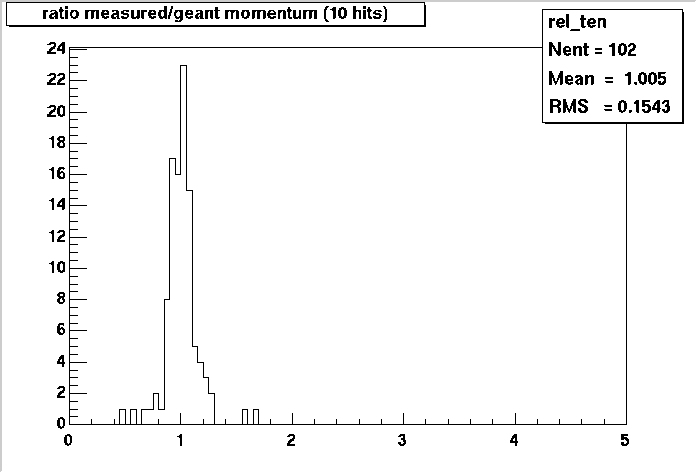
Half field: 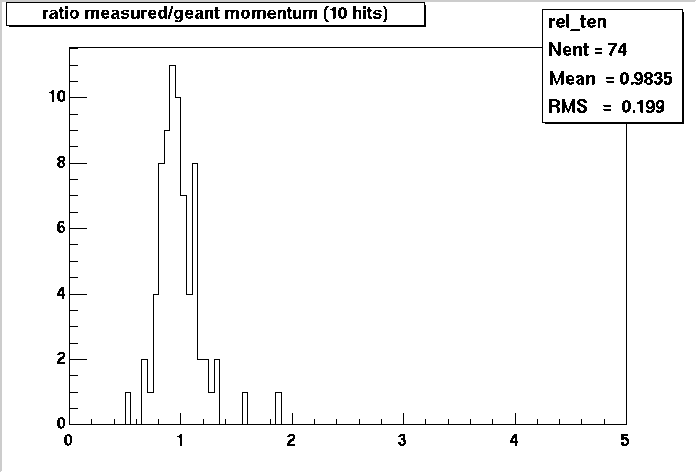
MDC1
FTPC and MDC1
The FTPC slow simulator chain:
- fss --- The FTPC Slow Simulator
- fcl --- The FTPC CLuster finder
- fpt --- The FTPC tracker
- fte - track evaluator
was included in the bfc.kumac for MDC1. NO dst information was written out.
Results:
We were able to find and correct programming errors which caused NaN's.
This page was written by Janet Seyboth on February 6, 1999
MDC2
FTPC and MDC2
In MDC2, the GEANT step size in the FTPC acceptance was reduced, so that every passing particle left a series of geant hits in every padrow. This became a serious challenge for the FTPC software and, even after optimization, increased the calculation time significantly. To get high-statistics for strangeness studies in the TPC, the planned schedule was changed in favor of more TPC fast simulator runs. Therefore, only a small number of events was run through the FTPC chain in MDC2, both with and without the slow simulator.
The complete FTPC slow simulator chain was run in the ROOT chain macro (bfc.C):
- St_fss_Maker --- The FTPC Slow Simulator
- St_fcl_Maker --- The FTPC CLuster finder
In runs when no raw_data from the FTPC slow simulator exists, St_fcl_Maker ran the FTPC fast simulator module ffs. - St_fpt_Maker --- ran the following FTPC modules:
fpt - track finder
fte - track evaluator
fde - dE/dx calculator
The FTPC track, point and dE/dx information was written out to the dst by St_glb_Maker.
This page was written by Janet Seyboth on February 6, 1999
MDC4
FTPC and MDC4
BNL, April 26 - May 10, 2001
Status History for FTPC in MDC4
Reconstruction
Purpose - MDC4 gave us the opportunity to test the performance and stability of our reconstruction chain with a large amount of simulated data before real data taking begins. It was the first large scale test of our slow simulator and cluster finder.
MDC4 Datasets - Dataset A (20,000 Au+Au MEVSIM events), DataSet B (100,000 pp PYTHIA events) and Dataset C (Au+Au peripheral STARLIGHT events) were processed in MDC4
BFC Chains - The FTPC ran only in the Au+Au BFC chain since our simulators can not handle pile-up
starnew new->SL00d
ROOT 3.00.06
bfc.C(#events,"MDC4","input dataset")
Identified Reconstruction Tasks
Implement StAssociationMaker
Pileup - we have to add pileup to our simulators in order to process pp simulation data (Contact: Akio,Jan)
Chisq - determine the correct values for the $STAR/StarDb/ftpc/ftpcClusterPars.C parameters
timeDiffusionErrors[1]
timeDiffusionErrors[2]
Reconstructed Datasets on FTPC BNL Cluster
There are 80 MEVSIM events in /cassini/data1/MDC4/Gstar/rcf0181_01_80evts.fzd
A complete set of output *.root files for these 80 events is available in /cassini/data1/MDC4
Analysis
Status - The analysis half of MDC4 was held for Friday, May 4 - Thursday, May 10
PWGs Expectations - The analysis focused on the new detectors and their physics capabilities
Spectra PWG - larger acceptance with FTPC
EbyE PWG - flow with FTPC
Strangeness PWG - first attempts to find v0's in FTPC
MDC4 Status Meetings
There was a telephone conference each Tuesday and Thursday at 3pm EST in the White Pit in Bldg. 118 (dial in x8261)
MDC4 Wrap-up Meeting
On Thursday, May 10 starting around 1:30pm EST there was a wrap-up meeting. Each sub-system was requested to summarize their experiences gained in MDC4 regarding efficiencies,problems encountered, etc. This summary should also contain a short summary on the new physics capabilities
JPWG Meeting
A PWG Workshop was held for Thursday, May 10 - Monday, May 14
This page was written by Janet Seyboth on April 27, 2001
Sim vs. Real Data - dAu
Comparison Slow Simulator and Real data dAu Min Bias
The Distribution of the number of hits-on-global-track is NOT the same for Real Data and Simulation with Hijing through the Slow Simulator (?) What happens with all this 10-hit-on-track ? The used Gain Table is not good enough to reproduce the holes?
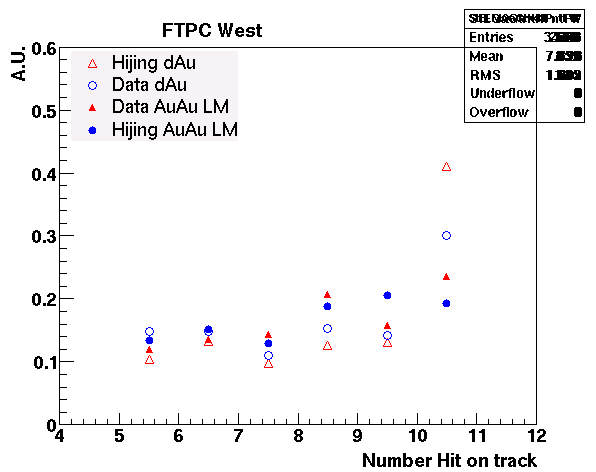 | 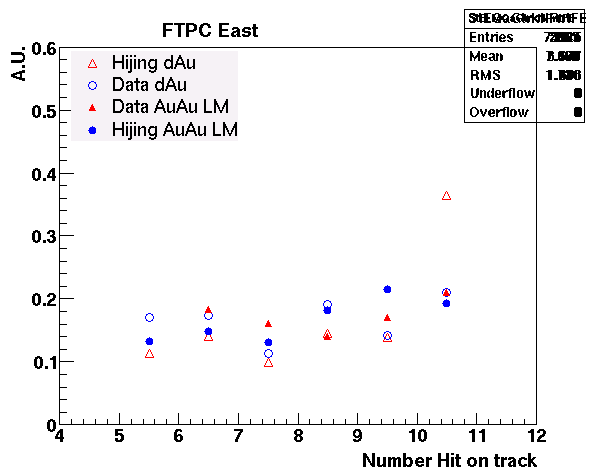 |
| FTPC West | FTPC East |
| AuAu minbias with low multiplicity in comparison with dAu min bias REAL DATA and SIMULATION | AuAu minbias with low multiplicity in comparison with dAu min bias REAL DATA and SIMULATION |
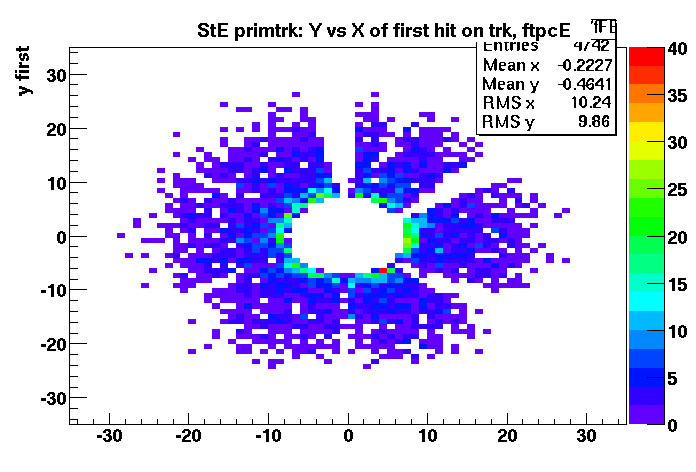 | 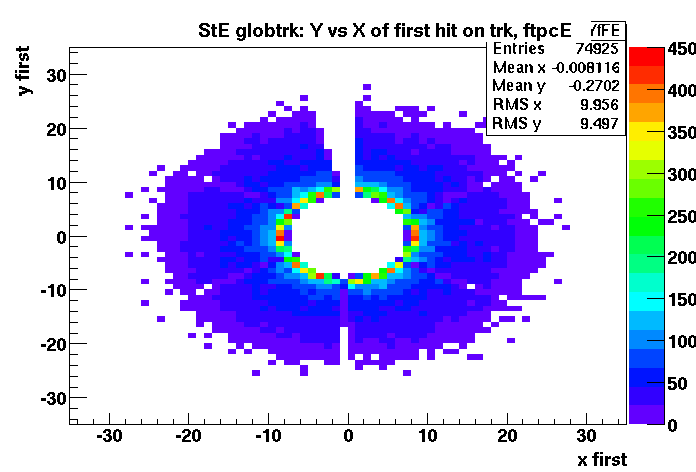 |
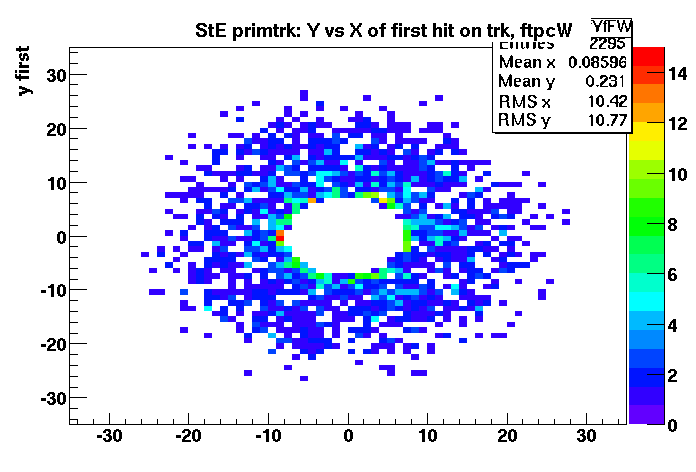 | 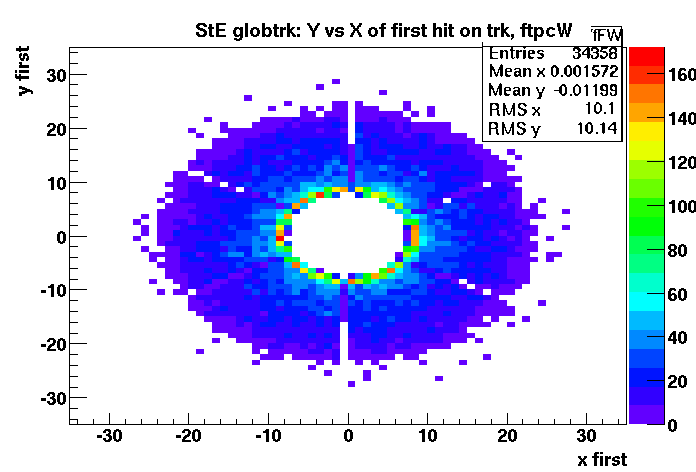 |
| REAL DATA | SIMULATION |
The residuals are much better for Simulation than for Real data. We still need to do something here )-:
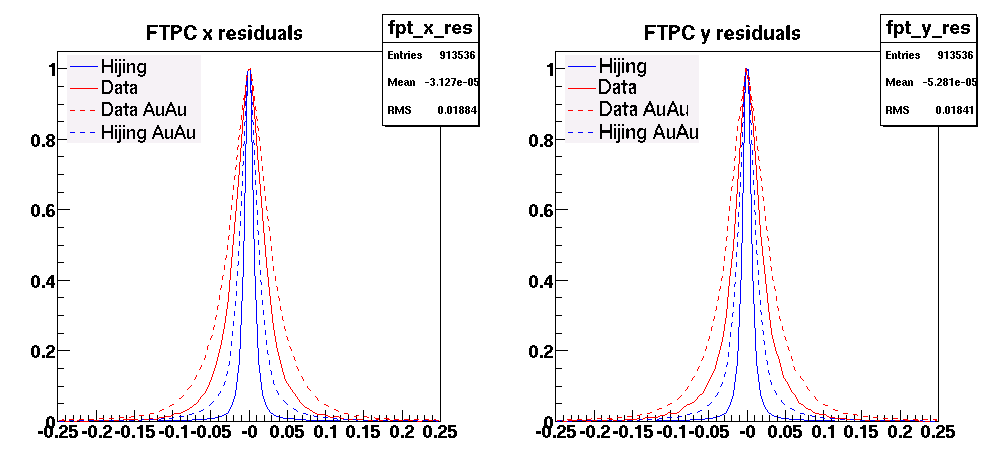
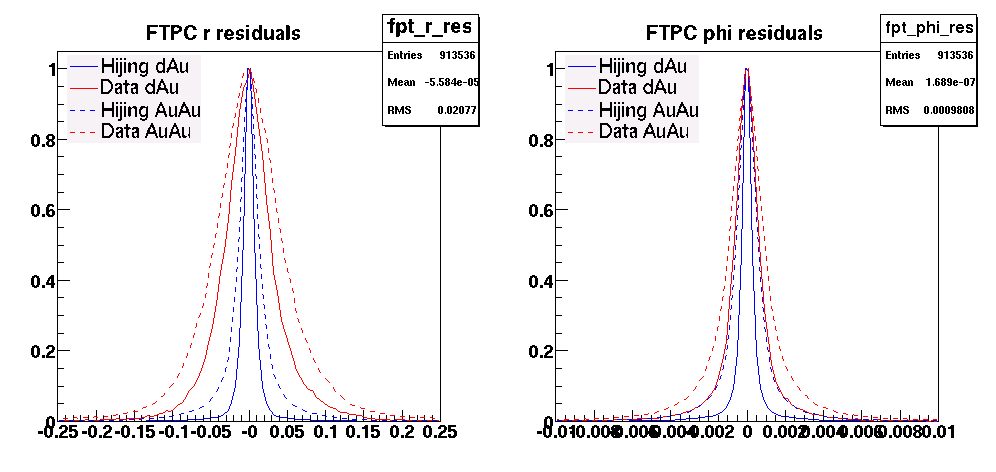
Sim vs. Real Data - AuAu
Comparison Slow Simulator and Real data for AuAu minbias events
The trend with the variation of the number of hits on track with the multiplicity is the same for Real Data and Simulation with Hijing through the Slow Simulator
| FTPC East | 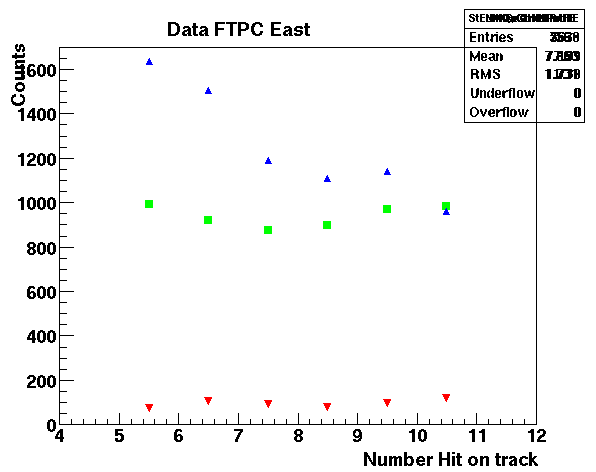 |
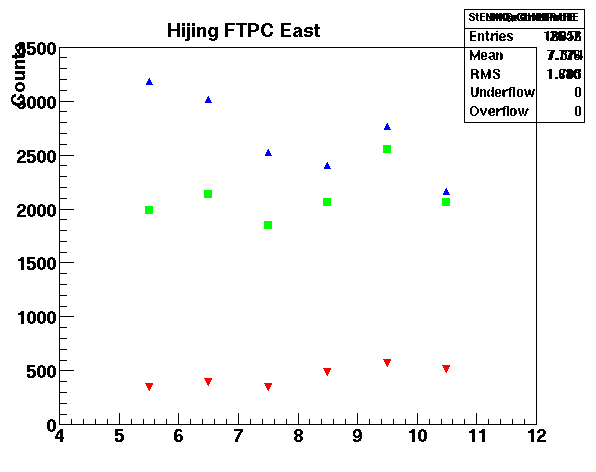 |
| AuAu minbias REAL DATA from Low Multiplicity (red) to High multiplicity (blue) | AuAu minbias SIMULATION from Low Multiplicity (red) to High multiplicity (blue) | |
| FTPC West | 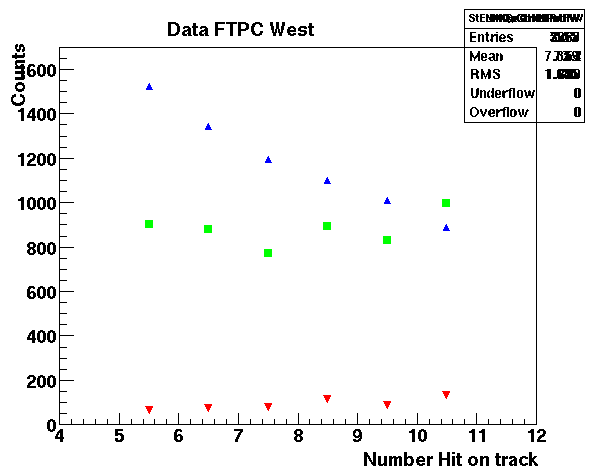 |
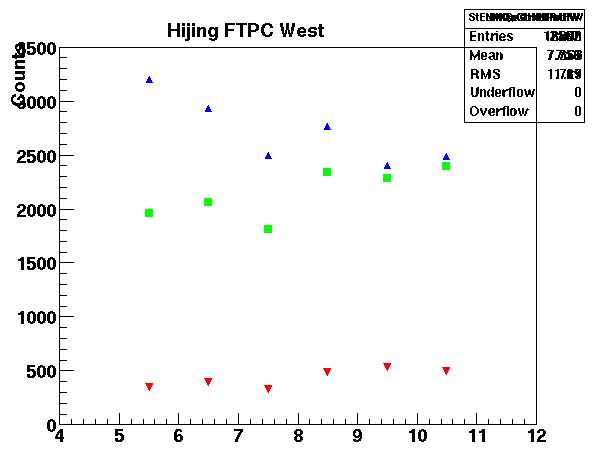 |
| AuAu minbias REAL DATA from Low Multiplicity (red) to High multiplicity (blue) | AuAu minbias SIMULATION from Low Multiplicity (red) to High multiplicity (blue) |
The residuals are much better for Simulation than for Real data. We still need to do something here )-:
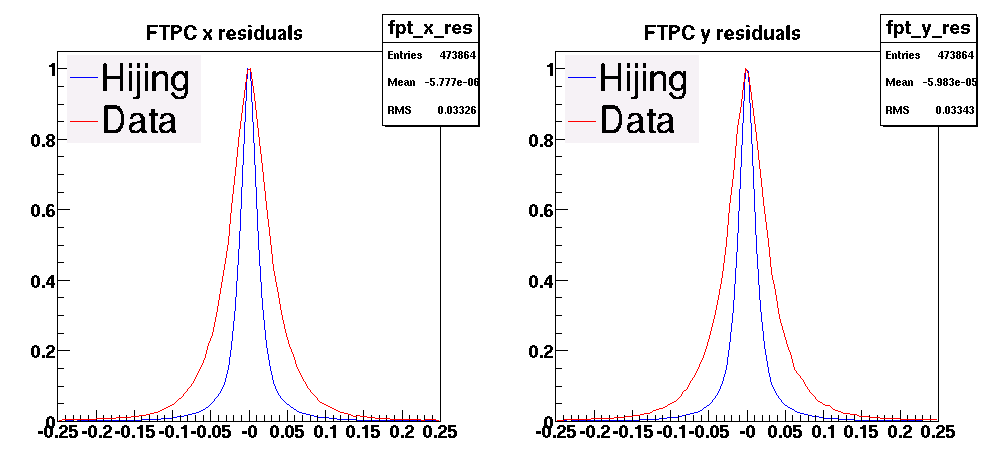
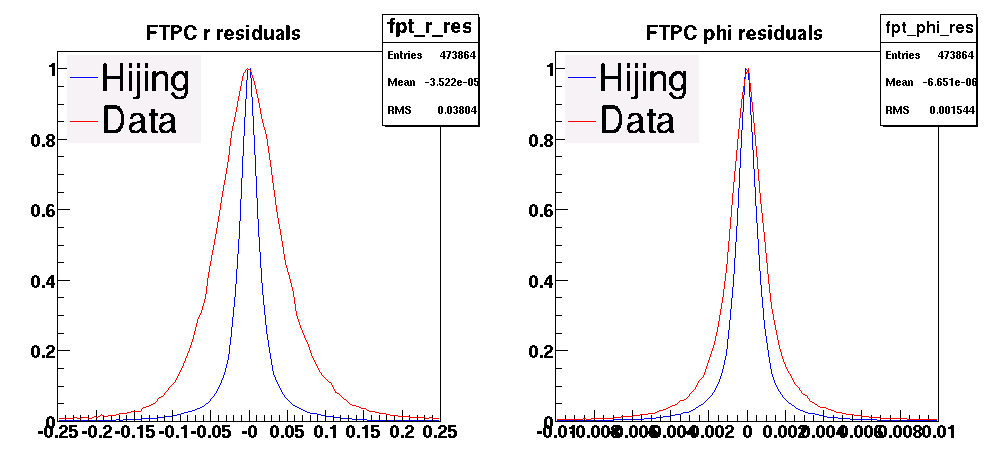
StFtpcFastSimu
StFtpcFastSimu - FTPC Fast Simulator
The FTPC fast simulator is implemented in C++ (as a part of StFtpcClusterMaker).
It was converted from Fortran (pam/ffs) to C++ by Holm Hümmler and is supported by Janet Seyboth.
StFtpcFastSimu simply takes the hit points registered by geant and turns them into FTPC points. Some cuts are applied to remove points that are outside the sensitive volume of the FTPC sectors and to account for the loss of hits due to cluster merging. Some of the geant information is kept in the gepoint table to be used in efficiency studies.
ftpcgeo
ftpcgeo.g
ftpcgeo.g defines the geometry for the FTPC in geant simulations. It contains information about the main aluminum cylinder, its support structures, the fieldcage and a rather detailed description of the readout chambers, and it defines the sensitive volumes.
Other geometry files of interest for the FTPC simulation are pipegeo.g for the beampipe and svttgeo.g with a description of the SVT, its support cone, the beampipe support and the shield layers.
This page was updated by Holm Hümmler on September 16, 1999